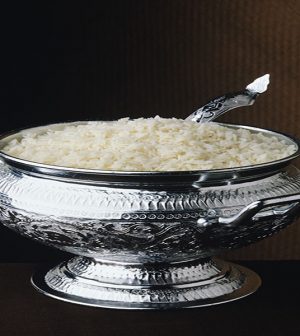- Navigating Your Midlife Crisis: Embracing New Possibilities
- City Raccoons Showing Signs of Domestication
- Mapping the Exposome: Science Broadens Focus to Environmental Disease Triggers
- One Week Less on Social Media Linked to Better Mental Health
- Your Brain Changes in Stages as You Age, Study Finds
- Some Suicide Victims Show No Typical Warning Signs, Study Finds
- ByHeart Formula Faces Lawsuits After Babies Sickened With Botulism
- Switch to Vegan Diet Could Cut Your Greenhouse Gas Emissions in Half
- Regular Bedtime Does Wonders for Blood Pressure
- Dining Alone Could Mean Worse Nutrition for Seniors
Arsenic and Rice: What You Need to Know

There’s a danger lurking in rice and you won’t find it by reading labels. It’s the chemical arsenic.
And the threat isn’t about immediate poisoning but rather that long-term exposure to small amounts can increase the risk of bladder, lung and skin cancer, heart disease and diabetes.
Arsenic naturally finds its way into our soil and water because it’s in the Earth’s crust, but it also accumulates from some pesticides and fertilizers.
Rice tends to absorb arsenic more readily than many other plants. Most unfortunate is that brown rice has the highest amounts because the arsenic accumulates in the otherwise healthful outer layers, which are removed to make white rice.
You don’t have to eliminate all rice from your diet, but choose it carefully, suggests the watchdog group Consumer Reports. Their testing found that arsenic levels differ depending on the types of rice and where they were cultivated.
Here are some tips to limit your rice intake:
- Choose white basmati and brown basmati rice cultivated in California, India and Pakistan, and sushi rice cultivated in the United States.
- Vary your whole grains to minimize arsenic exposure — try whole wheat, amaranth, buckwheat, millet, polenta and grits.
- Carefully read the labels of all food products: Rice, rice flour or brown rice syrup are in everything from gluten-free foods to teething biscuits.
High concentrations of arsenic in rice-based foods given to babies and children have led to recommendations to not give them rice drinks and to limit the number of servings of rice cereal. According to Consumer Reports, just one serving of rice cakes has close to a child’s weekly limit, and one serving of rice cereal and rice pasta could put kids over the maximum amount.
More information
The U.S. Food and Drug Administration has a position statement on arsenic in rice and more guidelines to limit exposure in infants.
Source: HealthDay
Copyright © 2025 HealthDay. All rights reserved.










